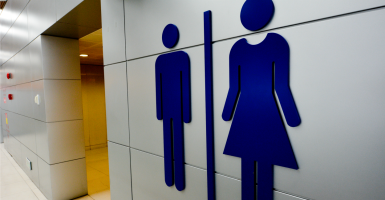The Fourth Circuit Court ruled today against a Virginia school district that sought to accommodate a transgender student while also protecting the privacy rights of other students.
The federal court concluded that Title IX of the Education Amendments of 1972—which prohibits discrimination on the basis of sex—should be interpreted as prohibiting discrimination on the basis of gender identity, as a Department of Education letter suggested in 2015. The ruling allows a lawsuit brought by a transgender student to proceed.
The case involves a biological girl who identifies as a boy. The court’s majority explains it this way: “G.G.’s birth-assigned sex, or so-called ‘biological sex,’ is female, but G.G.’s gender identity is male.” Note the scare quotes around what the court calls “so-called ‘biological sex.’” Biological sex, in fact, is precisely what Congress protected in 1972.
In a stinging dissent, Judge Paul Niemeyer points out that “the majority’s opinion, for the first time ever, holds that a public high school may not provide separate restrooms and locker rooms on the basis of biological sex.” It’s hard to imagine that that’s what Congress was prohibiting when it enacted Title IX in 1972.
Indeed, the court’s ruling goes against human history, practice, and common sense. Niemeyer explains:
This holding completely tramples on all universally accepted protections of privacy and safety that are based on the anatomical differences between the sexes. … schools would no longer be able to protect physiological privacy as between students of the opposite biological sex.
This unprecedented holding overrules custom, culture, and the very demands inherent in human nature for privacy and safety, which the separation of such facilities is designed to protect. More particularly, it also misconstrues the clear language of Title IX and its regulations. And finally, it reaches an unworkable and illogical result.
Niemeyer even points out that students have privacy rights to not have students of the other biological sex in their locker rooms:
Across societies and throughout history, it has been commonplace and universally accepted to separate public restrooms, locker rooms, and shower facilities on the basis of biological sex in order to address privacy and safety concerns arising from the biological differences between males and females. An individual has a legitimate and important interest in bodily privacy such that his or her nude or partially nude body, genitalia, and other private parts are not exposed to persons of the opposite biological sex. Indeed, courts have consistently recognized that the need for such privacy is inherent in the nature and dignity of humankind.
Nevertheless, G.G. sued the school district. Why? Because the district created a policy which says that bathroom and locker room access is primarily based on biology, while also creating accommodations for transgender students. Specifically, the policy is that only biological girls can use the girls’ room, only biological boys can use the boys’ room, and any student can use one of the three single-occupancy bathrooms, which the school created specifically to accommodate transgender students.
But even this accommodation wasn’t good enough. Hence the lawsuit and Tuesday’s ruling.
In a concurring opinion, Judge Andre Davis claims the student is at risk of “irreparable harm” if forced to use a single-occupancy bathroom. Davis says that to support the claim of “irreparable harm, G.G. submitted an affidavit to the district court describing the psychological distress he experiences when he is forced to use the single-stall restrooms.”
Davis adds that “G.G. experiences daily psychological harm that puts him at risk for long-term psychological harm, and his avoidance of the restroom as a result of the Board’s policy puts him at risk for developing a urinary tract infection as he has repeatedly in the past.” Davis concludes that for G.G. to use single-occupancy restrooms “is tantamount to humiliation and a continuing mark of difference.”
Niemeyer, however, points out that the majority relies not on the actual text, history, or legal implementation of Title IX, but on a 2015 letter from the Office for Civil Rights of the Department of Education: “The recent Office for Civil Rights letter, moreover, which is not law but which is the only authority on which the majority relies, states more than the majority acknowledges.” Indeed, that letter suggested that schools “offer the use of gender-neutral, individual-user facilities to any student who does not want to use shared sex-segregated facilities.”
At the end of the day, it’s hard to disagree with Niemeyer when he writes, “Any new definition of sex that excludes reference to physiological differences, as the majority now attempts to introduce, is simply an unsupported reach to rationalize a desired outcome.” This is simply an unaccountable agency and an activist court rewriting Title IX and remaking bathroom policy across our nation.
Bathroom, locker room, and shower facility policies that protect privacy based on biology while also accommodating transgender students make good sense. And as Niemeyer explains, they comply with the law, too: “When the school board assigned restrooms and locker rooms on the basis of biological sex, it was clearly complying precisely with the unambiguous language of Title IX and its regulations.”
































